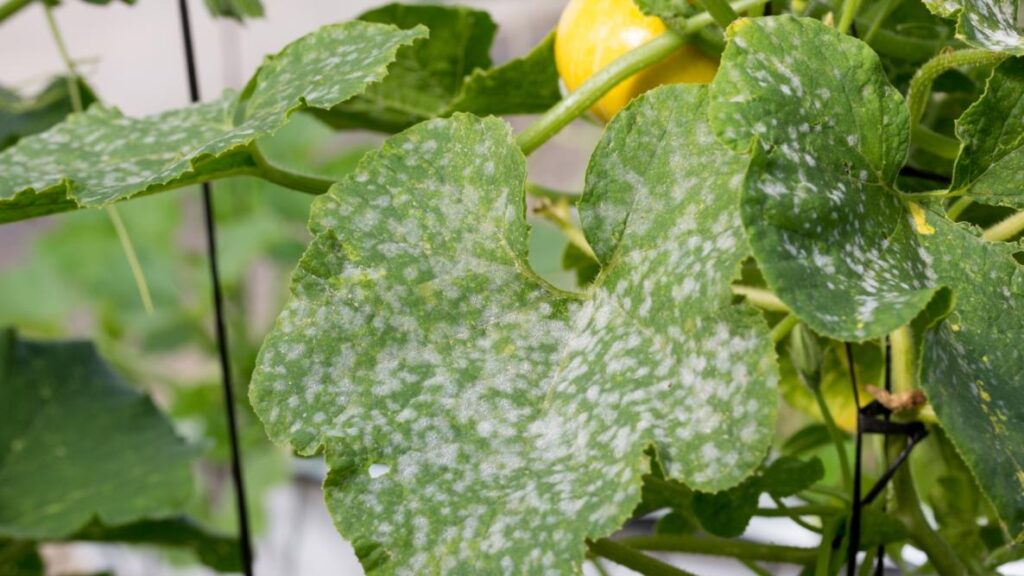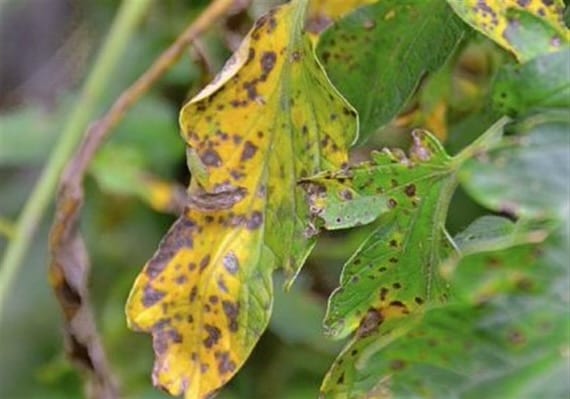If you’ve been following along with this article, you already understand how crucial it is to know the seriousness of farm diseases and learn effective strategies to combat them.
These diseases can be highly troublesome for farmers, and naturally, no farmer wants to experience their negative effects. In the previous section, we discussed three farm diseases: late blights, fusarium wilt, and downy mildew.
We covered their causes, symptoms, and the most effective methods to reduce their impact. Now, let’s explore three more farm diseases in this section. We will examine their causes and discover the best preventive and mitigation measures to combat them.
1. Powdery mildew
Powdery mildew is a common fungal disease that affects a wide range of plants, including vegetables, ornamentals, and fruit trees. It is caused by various fungal pathogens belonging to the order Erysiphales. These pathogens thrive in warm and humid conditions, making them more prevalent during the spring and summer seasons.

Symptoms
The symptoms of powdery mildew can include the following:
- White or Gray Powdery Patches: The most visible symptom of powdery mildew is the presence of white or gray powdery patches on the surfaces of leaves, stems, flowers, and fruits. These patches consist of fungal mycelium and spores.
- Distorted Plant Parts: As the disease progresses, the affected plant parts may become distorted. Leaves can curl, twist, or appear puckered due to the growth of the fungal colonies.
- Yellowing of Leaves: Infected leaves may develop yellow spots or yellowing overall. This discoloration occurs as the fungus interferes with the normal photosynthetic process, affecting the plant’s ability to produce energy.
- Premature Leaf Drop: Severe infections can cause affected leaves to prematurely drop from the plant. This can lead to a reduction in the overall foliage, negatively impacting the plant’s ability to carry out essential functions.
- Stunted Growth: Powdery mildew can hinder the growth of infected plants. As the disease progresses, it can weaken the plant, resulting in stunted growth, shorter stems, and smaller overall plant size.
- Reduced Crop Yield: Infected plants may experience reduced crop yield. The presence of powdery mildew can affect the development of flowers and fruits, leading to smaller or malformed produce.
Powdery mildew combat strategies
- Plant Resistant Varieties: Choose powdery mildew-resistant plant varieties whenever available. These varieties have a natural built-in resistance to the disease.
- Proper Spacing: Provide adequate spacing between plants to promote good air circulation. This helps reduce humidity around the foliage, making it less favorable for powdery mildew growth.
- Pruning: Remove dense or overcrowded foliage to increase airflow and reduce the chances of fungal spore buildup.
- Avoid Overhead Irrigation: Powdery mildew thrives in humid environments. Water plants at the base or use drip irrigation to keep the foliage dry and minimize moisture on leaves, which reduces the chances of infection.
- Watering Timing: Water plants early in the day, allowing the foliage to dry before nightfall. This prevents prolonged leaf wetness and creates unfavorable conditions for powdery mildew development.
- Fungicides: When preventive measures are not sufficient, the application of fungicides may be necessary. Choose fungicides specifically labeled for powdery mildew control and follow the recommended dosage, timing, and safety precautions. Rotate fungicides with different modes of action to reduce the risk of fungal resistance.
- Beneficial Organisms: Use biological control agents such as certain species of fungi (e.g., Trichoderma) or predatory mites that can feed on powdery mildew spores. These natural enemies can help suppress the disease.
2. Bacterial Blight
Bacterial blight is triggered by the presence of diverse bacterial pathogens, which can infiltrate plants through contaminated seeds, soil, or water sources.

Symptoms
- Water-Soaked Lesions: Infected plants display water-soaked lesions on leaves, stems, and fruits. These lesions are initially dark and often surrounded by yellow halos.
- Wilting and Leaf Death: As the disease progresses, the infected plant parts may wilt and eventually die. This is particularly evident in severe cases of bacterial blight.
- Oozing of Bacterial Sap: Infected lesions may release bacterial sap, appearing as a sticky substance on the surface. This oozing can be observed when the lesions are damaged or squeezed.
- Leaf and Fruit Drop: Severely affected plants may experience premature leaf drop, leading to defoliation. Additionally, infected fruits may exhibit lesions, become discolored, and drop prematurely.
- Stunted Growth: Bacterial blight can hinder the growth of infected plants, resulting in stunted development, reduced vigor, and overall diminished plant size.
Bacterial blight combat strategies
To combat bacterial blight and prevent its spread, the following strategies can be employed:
- Seed Selection and Treatment: Choose disease-resistant or tolerant seed varieties whenever available. If necessary, treat seeds with appropriate disinfectants or bactericides to reduce the presence of bacterial pathogens.
- Sanitation Practices: Practice good sanitation by removing and destroying infected plant material, including leaves, stems, and fruits. Maintain cleanliness in the field and surrounding areas to minimize the presence of bacterial pathogens.
- Crop Rotation: Implement a crop rotation schedule to disrupt the disease cycle and reduce the buildup of bacterial pathogens in the soil. Avoid planting susceptible crops in consecutive seasons in the same area.
- Proper Irrigation: Avoid overhead irrigation methods, as they can promote the spread of bacteria. Instead, use irrigation techniques that minimize water splashing and leaf wetting, such as drip irrigation.
- Balanced Fertilization: Maintain proper nutrient levels and ensure balanced fertilization practices. Avoid excessive nitrogen application, as it can promote lush growth and increase susceptibility to bacterial blight.
- Copper-based Sprays: Copper-based bactericides can be effective in managing bacterial blight. Apply these sprays according to the recommended dosage and timing, following label instructions.
3. Early Blight
Early blight is caused by a fungal pathogen that survives in the soil and plant debris during the off-season.

Symptoms
- Leaf Lesions: The primary symptom of early blight is the development of circular to irregularly shaped lesions on the leaves. These lesions typically start as small, dark spots and gradually enlarge over time. They often have a concentric or target-like appearance.
- Leaf Yellowing: Infected leaves may exhibit yellowing (chlorosis) around the lesions, especially as the disease progresses. The yellowing can extend beyond the lesion boundaries and affect larger areas of the leaf.
- Stem Lesions: In addition to affecting the leaves, early blight can also cause lesions on the stems of the plant. These lesions may be dark brown or black and can cause the stems to become weakened or shriveled.
- Fruit Lesions: Early blight can also affect the fruits of certain plants, such as tomatoes and potatoes. Infected fruits develop sunken, dark-colored lesions with concentric rings. As the lesions expand, they may become dry and leathery
- Leaf and Fruit Drop: Severe infections of early blight can lead to the premature defoliation of the plant, with infected leaves dropping off. In some cases, the disease can also cause infected fruits to drop prematurely from the plant.
It’s important to note that the severity and progression of symptoms can vary depending on the host plant, environmental conditions, and the stage of infection.
Early blight combat strategies
To combat early blight and prevent its spread, the following strategies can be implemented:
- Crop Rotation: Practice crop rotation by avoiding planting susceptible plants in the same location for consecutive seasons. Rotate crops with non-host plants to break the disease cycle and reduce the buildup of fungal spores in the soil.
- Sanitation: Remove and destroy infected plant debris, including leaves, stems, and fruits, both during the growing season and at the end of harvest. This reduces the source of fungal spores and helps prevent overwintering.
- Proper Watering: Avoid overhead irrigation or watering techniques that wet the foliage. Instead, water at the base of plants to minimize leaf wetting and reduce the favorable conditions for disease development.
- Adequate Spacing and Air Circulation: Provide sufficient spacing between plants to ensure good air circulation. This helps to reduce humidity levels and allows leaves to dry quickly after rainfall or irrigation, reducing the risk of infection.
- Mulching: Apply a layer of organic mulch around plants to prevent soil splashing and reduce the risk of fungal spores being splashed onto lower leaves. Mulch also helps maintain more even soil moisture levels.
- Disease-Resistant Varieties: Select and plant crop varieties that are resistant or tolerant to early blight when available. These varieties have built-in genetic resistance that can help reduce the severity of the disease.
- Regular Monitoring: Regularly inspect plants for early signs of infection, such as leaf lesions or discoloration. Early detection allows for timely intervention and management measures to minimize the spread of the disease.
Conclusion
Remember to consult with local agricultural experts or extension services for specific recommendations tailored to your region and crop type, as management strategies may vary depending on local conditions and regulations.